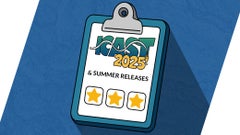James Niggemeyer's Pattern, Baits & Gear
"It took me a long time as a pro to realize that, maybe four or five years really. Cliff Crochet and I talk about this and finding your angling identity and what kind of fisherman you are and where you have had the most success. I had the mindset that I wasn't going to look out. My only time spent out there was in the mid-range grass in 7 to 10 feet. I'm very comfortable in deep grass, so I was either going to eliminate or establish it and I totally eliminated it during official practice." So that left the bank, which he pounded and pounded to the tune of 29-09 and his best career finish in a top-level tournament. For Niggemeyer, whose angling roots were shaped in California before moving to Texas, the process of going shallow at Ouachita was a stark contrast to fishing shallow elsewhere. Rather than try to develop a true pattern, it literally boiled down to covering as much water as he could. "It was one of those things where I had to just turn my brain off and just go," he said. "It's amazing because you train your mind to put together the pieces of why are the fish there and why am I getting bit. We do that to make ourselves more efficient. This was the complete opposite of that." Here are a few more details about how Niggemeyer rode the shallow bite to the runner-up position at Ouachita.
Practice:
Niggemeyer spent roughly two full days at Ouachita prior to off-limits, not so much to fish the lake, but to get re-acclimated to the surroundings. "I basically spent most of the time driving around and about a one-third of the time fishing," he said. "The year before, I came out for a St. Croix Rods photo shoot and we just stayed near Mountain Harbor, but hardly did any fishing. Prior to that, I hadn't been there since 2005." That's when he won a three-day BFL Regional in October 2005 with a total of 50-04.
The fishing wasn't near as good this time around. "I didn't establish a thing other than I caught one fish before cutoff and it may have been a non-keeper," he said. "I had nothing established. I was more interested in looking at the water color and the grass and depth of the grass. It looked like the conditions stayed consistently hot throughout that time before the tournament." He found a decent amount of shallow grass around the Crystal Springs area, but he didn't establish whether fish were using that grass. "It was the shallowest grass on the lake," he said. "I thought, ÔThere has to be fish there."
When official practice got going, he caught one up shallow and saw several others cruising along the bank. He'd seen enough. "I was all in at that point," he said. He checked some grass areas on day 2, but his confidence in the shallow strategy was set. "If you fish the Colorado River lakes, that summertime topwater pattern is so strong and with me being from the West Coast, I felt comfortable doing that," he added.
Competition:
Niggemeyer says Ouachita last week reminded him of how Lake Mead fished during the 2004 U.S. Open, in which he finished 19th. "Everything I caught was either on the surface walking or burning a spinnerbait in 5 to 7 feet of water," he said. "To me, Ouachita sets up - with the clear water and grass - very similar to a Colorado River Lake." On day 1, he overcame a slow morning to weigh 12-02, one of just seven bags of 12 pounds or more caught in the tournament. It was anchored by a 4-plus pounder and had him in 5th place after the initial competition day. Toward the end of the day, he started to expand his search area to include new water. On day 2, he recycled some areas to his benefit, but realized toward the end of the day it was time to start adding fresh water.
"My biggest fish on days 1 and 2 were caught within a couple hundred yards of each other," he said. By the final day, four of the five fish he weighed in were caught off stretches he hadn't fished before. Many of the places he fished were pockets that included points and stretches with standing timber or stumps close to shore. He said most of the bites came between the shoreline and the inside edge of the wood line. caught one off a piece of wood, it was generally a spotted bass," he said. "There were some on banks with no timber at all. There was nothing there."
One thing he had to control was his urge to chase schooling fish. At Ouachita, they'd randomly come up in the middle of a pocket or out in the creek leading to where he was fishing. He found it was a frustrating endeavor and remained focused on his topwater approach along the bank. "I fished an Open there in 2004 and felt like I was on the winning school of schoolers," he recalled. "It was the late September timeframe and I remember I frothed the water. I tried everything I knew from fishing heavily pressured water in California. I almost pulled my hair out trying to figure something out they'd bite. They're harder to catch than any other fish in that lake. So I decided if it pops up in front of me, I'll fish it, but I'm not going to devote a lot of time to it." With the hot, clear water, Niggemeyer said he had several fish come from a long way to attack his bait and some of the strikes were as vicious as any he can remember. "They have a much larger strike zone in that clearer water," he said. "On day 1, I threw my buzzbait in the back of a pocket and out of my periphery I see this fish coming from a ways away. It was a like a streak of lightning and he just mauled my bait. It looked like a little one, but I reeled him in and it was a 2-pounder. Those fish can see so much further in that clear water and they're not opposed to running a ways to get a bite. That's because they're accustomed to foraging in that environment versus stained water."
Gear Notes:
Topwater gear: 7'4" heavy-action St. Croix Legend Elite casting rod, Casting reel (8:1 ratio), 50-pound TUF-LINE XP braided line, 1/4-oz. unnamed custom buzzbait, unnamed toad trailer (green-pumpkin).
He also threw a Strike King Sexy Dawg when fish would school on top. That was on a 7' St. Croix Legend Extreme with 30-pound braid to a 20-pound Gamma Co-Polymer leader.
Main factor: "Just putting those topwaters in my hand and just going and also being willing in a tough bite to run new water. It's so hard when you have a tough tournament and have success, you have to fight the urge to run back where you caught fish. Sometimes, I'd feel like I needed to go back through and when I did, I didn't catch anything."
Performance edge: "My batteries. This reminded me of sight-fishing practice where you don't even cast. You just have your trolling motor on high and you're marking as many on beds as you can. I used my trolling motor so much that it reminded me of that, but I was fishing the whole time. My trolling motor batteries lasted all day, but by the time we'd drive into Hot Springs and weighed in and did our media stuff and had dinner, we weren't able to get enough charging hours each night. My batteries on days 2 and 3 only got to 75 percent, but I still made it through the day."
FLW Tour Forrest Woods Cup Lake Ouachita Runner-Up Pattern BassFan 8/15/18 (Todd Ceisner)








